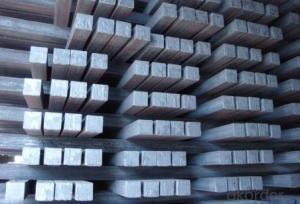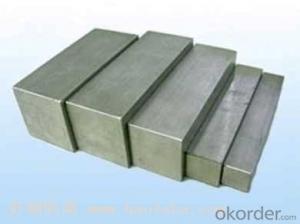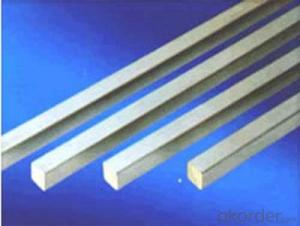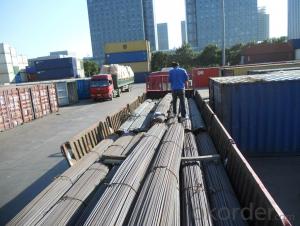Q195B Square bar steel for construction made in China
- Loading Port:
- Tianjin
- Payment Terms:
- TT or LC
- Min Order Qty:
- 10000 m.t.
- Supply Capability:
- 10000 m.t./month
OKorder Service Pledge
OKorder Financial Service
You Might Also Like
Product Description:
OKorder is offering Q195B Square bar steel for construction made in China at great prices with worldwide shipping. Our supplier is a world-class manufacturer of steel, with our products utilized the world over. OKorder annually supplies products to European, North American and Asian markets. We provide quotations within 24 hours of receiving an inquiry and guarantee competitive prices.
Product Applications:
Q195B Square bar steel for construction made in China are ideal for structural applications and are widely used in the construction of buildings and bridges, and the manufacturing, petrochemical, and transportation industries.
Product Advantages:
OKorder's Q195B Square bar steel for construction made in China are durable, strong, and resist corrosion.
Main Product Features:
-Standard: GB,
-Grade: Q195 or equivalent.
-Chemical Composition:
Standard | Grade | Element (%) | ||||
GB | Q195 | C | Mn | S | P | Si |
0.06~0.12 | 0.25~0.50 | ≤0.050 | ≤0.045 | ≤0.30 | ||
Measures of HR Square Bar (small measures):
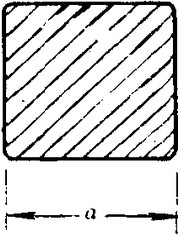
(Section of HR Square Bar)
-Length of a side and Theoretical weight of Square Bar.
Length of a side(mm) | Theoretical weight(kg/m) | Length of a side(mm) | Theoretical weight(kg/m) |
7 | 0.385 | 22 | 3.80 |
8 | 0.502 | 24 | 4.52 |
9 | 0.636 | 25 | 4.91 |
10 | 0.785 | 26 | 5.30 |
11 | 0.950 | 28 | 6.15 |
12 | 1.13 | 30 | 7.06 |
13 | 1.33 | 32 | 8.04 |
14 | 1.54 | 34 | 9.07 |
15 | 1.77 | 36 | 10.17 |
16 | 2.01 | 38 | 11.24 |
17 | 2.27 | 40 | 12.56 |
18 | 2.54 | 42 | 13.85 |
19 | 2.82 | 45 | 15.90 |
20 | 3.14 | 48 | 18.09 |
21 | 3.46 | 50 | 19.63 |
Notes:
1, The theoretical weights in the list, base on the density of 7.85 g/cm3.
2, Formula for theoretical weight of Square bar: (length of a side)2 * 0.00785
3, The numbers with *mean that they are not regular or we don’t offer them.
-Regular length of Square Bar:
Steel | Length of a side (mm) | Length of steel (m) |
Normal steel | < 25 | 4~10 |
> 25 | 3~9 | |
Steel of high quality | All measure | 2~6 |
Tool steel >75 | 1~6 |
Usage/Applications of HR Square Bar:
-The Square Bar is normally used as structure steel.
-Row material for other structure steel like steel angles, channels, I-beams, H-beams, etc…
Packaging & Delivery of HR Square Bar:
-Packing Detail: The products can be packed in bundles by steel wires.
-Marks: We make tag marks and color marks. The tag marks with white background and red company logo will be tied up to each bundle of the products. The information is usually including basic information of products and company and other information requested by customers. As for color marks, we will paint both ends of bundles to make sure that it will be more convenient for customers to distinguish them from other products.
-Delivery Detail: 30~45 working days after receive buyer’s T.T. or L/C.
Transportation:
-The products can be delivered by bulk vessel or by container. As for container, products with the length of 6m will be loaded in 20’ container, with 9m or 12m, in 40’ container.
-The maximum quantity of loading of container is 25 tons.
-The products are usually transported to the nearest port from the production place.
FAQ:
Q1: How soon can we receive the product after purchase?
A1: Within three days of placing an order, we will begin production. The specific shipping date is dependent upon international and government factors, but is typically 7 to 10 workdays.
Q2: What makes stainless steel stainless?
A2: Stainless steel must contain at least 10.5 % chromium. It is this element that reacts with the oxygen in the air to form a complex chrome-oxide surface layer that is invisible but strong enough to prevent further oxygen from "staining" (rusting) the surface. Higher levels of chromium and the addition of other alloying elements such as nickel and molybdenum enhance this surface layer and improve the corrosion resistance of the stainless material.
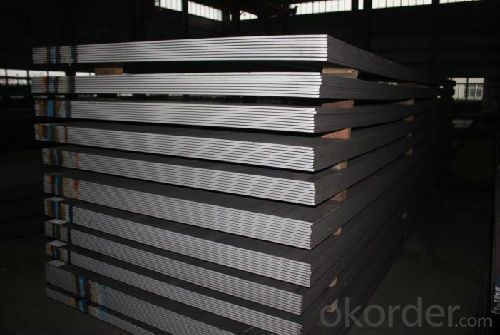
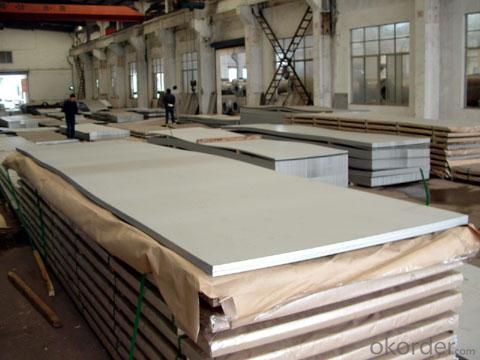
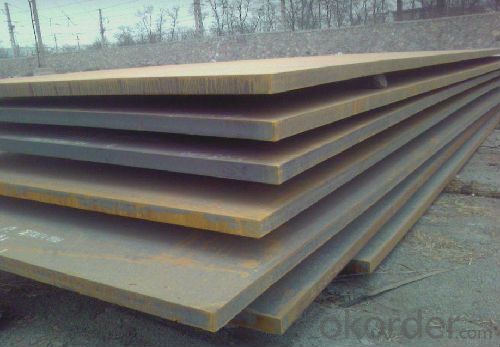
- Q:How do you use a steel square to lay out a hip rafter with unequal pitch?
- To lay out a hip rafter with unequal pitch, follow these steps: 1. Start by determining the pitch angles of both roofs that meet at the hip rafter. It's important to note that these angles will be different due to the roofs having unequal pitches. 2. Position the steel square on the tail of the hip rafter, aligning the shorter leg with the plumb cut of the rafter. 3. Use the longer leg of the square to mark the rise and run measurements based on the pitch angles of each roof. The rise represents the vertical height, while the run represents the horizontal distance. 4. Measure and mark the length of the hip rafter on the side with the plumb cut. Typically, this measurement is based on the overall length required for the hip rafter. 5. Connect the marks for the rise and run, extending the lines until they intersect with the mark for the overall length. This will provide you with the outline of the hip rafter. 6. Carefully cut along the outlined shape of the hip rafter using a saw. Precision is key to ensure a proper fit during installation. Always remember to double-check all measurements and angles before cutting the hip rafter. It's also advisable to consult a professional or refer to a comprehensive guide on using a steel square for more detailed instructions specific to your project.
- Q:Can a steel square be used for checking the alignment of fence posts?
- Indeed, the alignment of fence posts can be checked using a steel square. Serving as a multipurpose tool, the steel square is capable of fulfilling numerous measuring and marking duties, which notably includes assessing the alignment of fence posts. By positioning the steel square alongside the post and utilizing it as a reference, one can guarantee the post's impeccable verticality and alignment. The steel square's perpendicular angle and precise edges render it an optimal instrument for this endeavor, enabling a straightforward determination of any leaning or misalignment of the post.
- Q:How do you use a steel square to determine the length of a hypotenuse?
- To use a steel square to determine the length of a hypotenuse, you would first align one side of the square (usually the longer leg) with the known length of one side of the right triangle. Let's call this side "a". Next, extend the other side of the square (usually the shorter leg) until it intersects with the unknown hypotenuse. Let's call this side "b". Now, measure the distance from the starting point of the known side "a" to the point where the extended side "b" intersects with the hypotenuse. This measurement represents the length of side "b". Finally, using the Pythagorean theorem, which states that the square of the hypotenuse is equal to the sum of the squares of the other two sides (a^2 + b^2 = c^2), you can calculate the length of the hypotenuse "c" by substituting the values of sides "a" and "b" into the equation and solving for "c".
- Q:How do you use a steel square to determine the slope of a gutter?
- In order to determine the slope of a gutter using a steel square, the following steps should be followed: 1. Begin by measuring the width of the gutter using the outer edges of the steel square. Make sure that the square is firmly pressed against the gutter. 2. Proceed by positioning one side of the steel square against the bottom of the gutter, ensuring that it is level. The other side of the square should extend vertically towards the top edge of the gutter. 3. Verify that the steel square is perfectly vertical by using a level. If necessary, make adjustments. 4. Once the steel square is aligned correctly, examine the measurement markings on the square. The vertical side of the square indicates the rise or fall, while the horizontal side represents the run or distance. 5. Take note of the measurement where the horizontal side of the square intersects with the top edge of the gutter. This measurement will provide you with the rise or fall of the gutter. 6. To calculate the slope, divide the measurement of the rise or fall by the width of the gutter. This will yield the slope ratio, which can be expressed as a percentage or a ratio (e.g., 1:100). Utilizing a steel square to determine the slope of a gutter is an effective technique as it enables precise measurements and guarantees the proper installation of the gutter for efficient drainage.
- Q:Can a steel square be used for checking the alignment of walls?
- Yes, a steel square can be used for checking the alignment of walls. The straight edges of the square can be placed against the walls to determine if they are perpendicular or at the desired angle. The square can also be used to check for plumbness by aligning it vertically against the walls.
- Q:What are the different uses of a steel square in metalworking?
- In metalworking, a steel square, also known as a framing square or carpenter's square, is a versatile tool with various applications. Here are several ways in which a steel square is used: 1. Measurement and marking: A key function of the steel square is to accurately measure and mark straight lines, angles, and right angles. The blade, the long arm of the square, can measure the length or width of a metal piece, while the tongue, the shorter arm, can mark lines or angles on the metal surface. 2. Squareness checking: Checking the squareness or perpendicularity of metal components is an important task, and a steel square is ideal for this purpose. By placing the square's tongue against a flat surface and aligning the blade with the edge of another metal piece, one can determine if the angle is exactly 90 degrees. This ensures precise fitting during fabrication or assembly. 3. Layout and marking: Steel squares are frequently used for layout work in metalworking. They aid in transferring measurements and dimensions from plans or templates to the metal surface. By utilizing the blade and tongue of the square, accurate lines, angles, notches, and holes can be marked on the metal, ensuring precise fabrication. 4. Cutting and sawing: Steel squares serve as guides for cutting or sawing metal pieces. By aligning the square's blade with the desired cut line and holding it firmly against the metal surface, one can guide the cutting tool, such as a hacksaw or circular saw, along the square. This ensures a straight and accurate cut. 5. Flatness checking: Steel squares are useful for assessing the flatness of metal surfaces. By placing the blade or tongue of the square against the metal surface and observing any gaps or inconsistencies, areas that require flattening or leveling can be identified. 6. Angle layout and marking: Steel squares have markings and graduations along their blade and tongue, enabling precise angle layout and marking. By aligning the square with the desired angle measurement and marking the corresponding point on the metal, accurate angled cuts or joints can be created. Overall, a steel square is an indispensable tool in metalworking, aiding in measurement, marking, squareness checking, layout work, cutting, and ensuring accuracy and precision throughout the fabrication process.
- Q:How do you use a steel square to measure diagonal distances?
- To use a steel square to measure diagonal distances, you would place one end of the square against the starting point of the diagonal line, ensuring that the blade of the square is aligned with the line. Then, extend the blade so that it reaches the end point of the diagonal line. The measurement on the blade where it aligns with the end point will give you the diagonal distance.
- Q:Can a steel square be used for checking the squareness of a cabinet?
- Yes, a steel square can be used for checking the squareness of a cabinet.
- Q:Can a steel square be used for plumbing and pipefitting?
- Yes, a steel square can be used for plumbing and pipefitting. A steel square, also known as a carpenter's square or a framing square, is a versatile tool that can be used to measure and mark angles, check for squareness, and ensure accurate cuts and joints. In plumbing and pipefitting, a steel square can be used to measure and align pipes, make precise cuts, and ensure proper angles and squareness in fittings and connections. It can also be used to mark reference points and guide the installation of pipes and fixtures. However, it is important to note that for more specialized tasks in plumbing and pipefitting, there are other tools specifically designed for those purposes that may be more suitable and accurate.
- Q:How do you use a steel square to lay out a stair stringer?
- To use a steel square for laying out a stair stringer, follow these steps: 1. Gather the necessary tools: a steel square, a tape measure, a pencil, a framing square, and a saw. 2. Start by determining the total rise of the stairs. Measure the vertical distance from the finished floor at the bottom to the finished floor at the top of the stairs. This measurement will determine the number of risers needed. 3. Determine the desired height of each riser. Building codes typically require a riser height between 6 and 8 inches. Divide the total rise by the desired riser height to calculate the number of risers. 4. Next, determine the tread depth. Building codes typically require a tread depth between 9 and 11 inches. Measure the horizontal distance between the finished floor at the bottom and the finished floor at the top of the stairs. Divide this measurement by the number of treads to determine the tread depth. 5. Lay the framing square on the edge of the stringer, aligning the heel of the square with the bottom of the stringer and the blade with the tread depth measurement. Mark a line along the blade of the square. 6. Move the square up to the top of the stringer, aligning the heel with the top and the blade with the riser height measurement. Mark a line along the blade of the square. 7. Connect the two lines marked on the stringer to form the outline of the stringer. Use a straight edge to ensure that the lines are straight and square. 8. Repeat this process for the desired number of stringers, typically two for a standard staircase. 9. Use a saw to cut along the lines marked on the stringer to create the stair stringer. By following these steps and using a steel square, you can accurately lay out a stair stringer and ensure the construction of a safe and properly aligned staircase.
1. Manufacturer Overview |
|
|---|---|
| Location | |
| Year Established | |
| Annual Output Value | |
| Main Markets | |
| Company Certifications | |
2. Manufacturer Certificates |
|
|---|---|
| a) Certification Name | |
| Range | |
| Reference | |
| Validity Period | |
3. Manufacturer Capability |
|
|---|---|
| a)Trade Capacity | |
| Nearest Port | |
| Export Percentage | |
| No.of Employees in Trade Department | |
| Language Spoken: | |
| b)Factory Information | |
| Factory Size: | |
| No. of Production Lines | |
| Contract Manufacturing | |
| Product Price Range | |
Send your message to us
Q195B Square bar steel for construction made in China
- Loading Port:
- Tianjin
- Payment Terms:
- TT or LC
- Min Order Qty:
- 10000 m.t.
- Supply Capability:
- 10000 m.t./month
OKorder Service Pledge
OKorder Financial Service
Similar products
New products
Hot products
Related keywords
